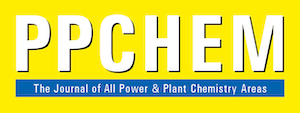
For members only
ABSTRACTS
Treating Make-up Water and Condensate by Reverse Osmosis in an LP Vinyl Records Pressing Plant
Pavel Hübner
At the Czech company GZ Media a.s., which produces vinyl records, the vinyl presses are heated by steam and after pressing, the steam is rinsed from the press by cooling water. The condensate therefore contains a high proportion of cooling water.
In the original system, the losses of steam and cooling water were replaced by filtrated and softened raw water. The polluted condensate was also treated by filtration and softening. The water used as make-up, which was originally considered drinking water, has been replaced for economic reasons by surface water with high salinity and alkalinity. Due to high operational costs and other considerations the original design was replaced with a new one in 2019.
The new system treats the mixture of raw water and cooled condensate by on-line coagulation followed by reverse osmosis. The hot condensate is cooled by heat exchange, which transfers the heat to the permeate as feedwater. The new system exhibits very low boiler blow-down, minimal consumption of chemicals and low operator attendance.
PPCHEM® 2020, 22(3), 104–109
For Members only
Calculations to Manage Phosphate and Caustic Treatment
Randy C. Turner
Phosphate and/or caustic (NaOH) treatment boiler water treatment is often employed to reduce the risk of corrosion.
This paper describes empirical calculations for proper control of phosphate and caustic treatment which could be incorporated into an Excel spreadsheet which includes several calculations, of which the most important are:
- Boiler water ammonia corrected pH
- Sodium to phosphate molar ratio
- Free sodium hydroxide concentration
- Amount of phosphate and/or caustic to dose for a specific concentration at the current operating pressure
This can also be used to calculate how much caustic must be added to an AVT treated boiler to achieve a desired pH-value.
PPCHEM® 2020, 22(3), 112–117
For Members only
The Impact of Low-Load Operation on Power Plant Chemistry
Frank Udo Leidich
Nowadays conventional power plants are more challenged in regard to load flexibility and especially frequent(very) low-load operation. While the so-called “dark doldrums” must be managed without de-stabilizing the grid,a bright sunny and windy day requires almost no conventional power generation. This kind of operation not onlystresses the plant components mechanically and thermally, leading to accelerated aging of the plant, but the physico-chemical operation also becomes more challenging. This paper highlights the most important aspects of theimpact of low-load operation on the chemical operation of a power plant. It is shown that it pays to operate the unitwith water and steam that is as clean as possible.
PPCHEM® 2020, 22(3), 118–129

